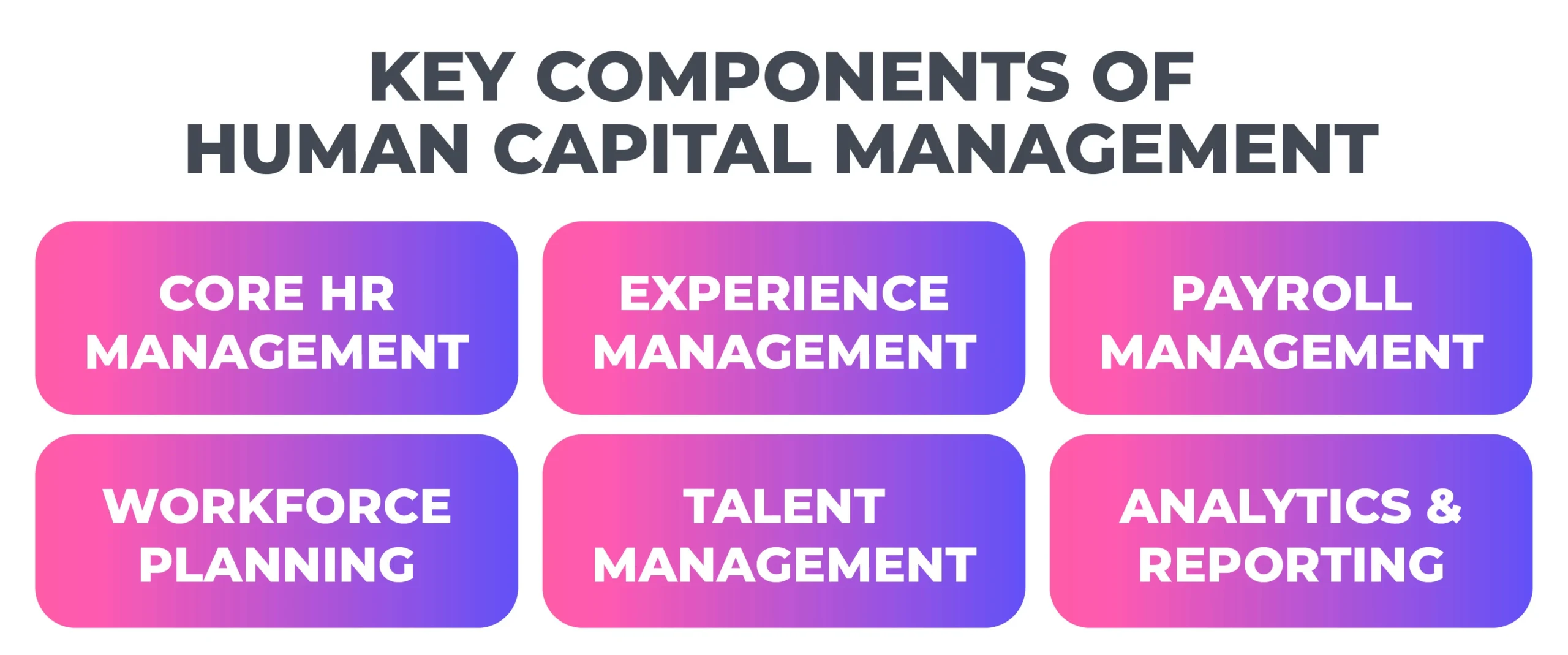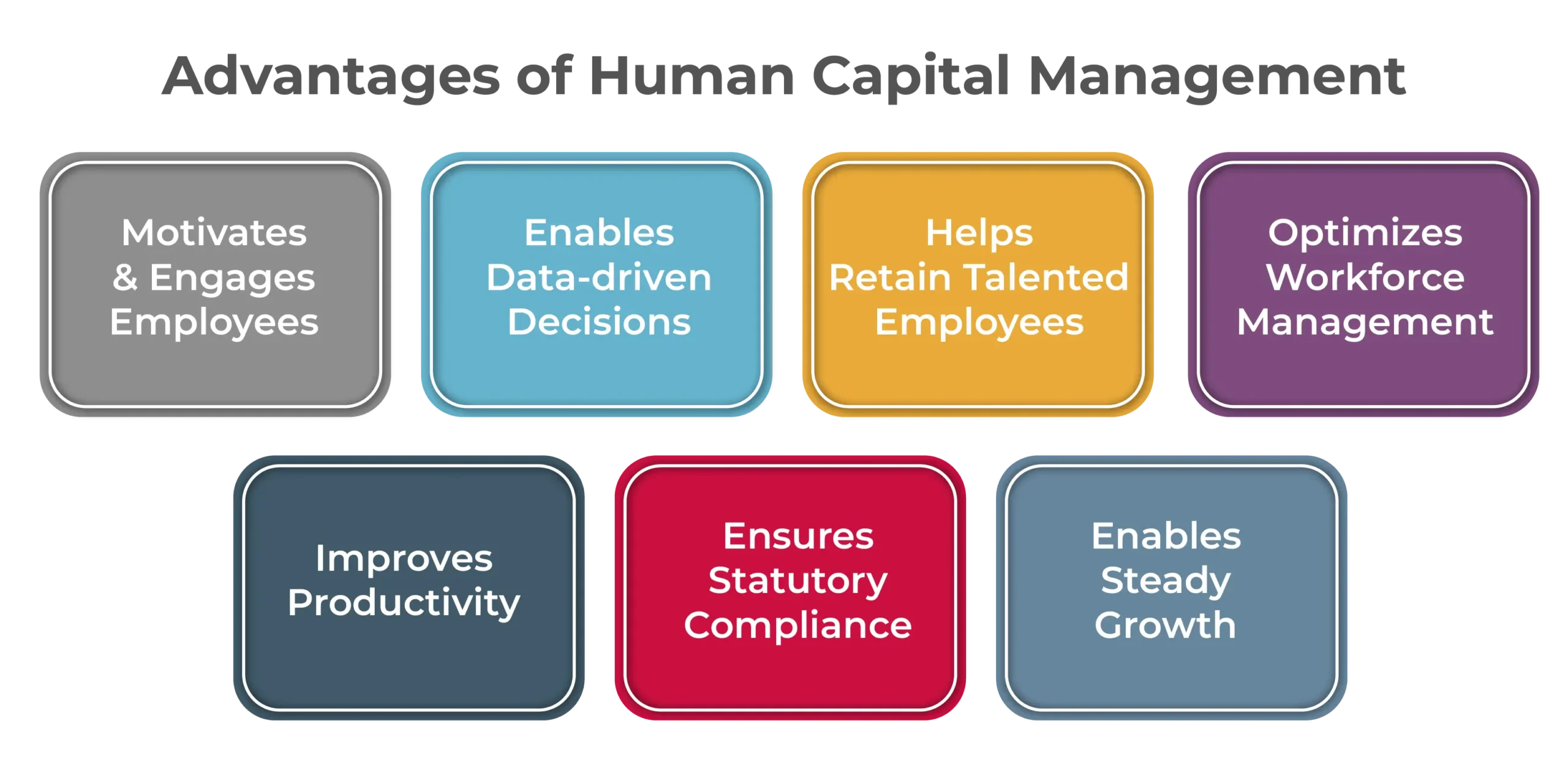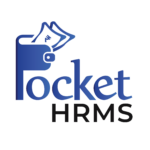
Human Capital Management (HCM)
Table of Contents

Reading Time: 9 minutes
What is Human Capital Management (HCM)?
Human Capital Management (HCM) is the collective approach to attract, recruit, train, and manage the employees of an organisation. It considers the workforce of a company to be its ‘capital’, and their knowledge and expertise to be valuable commodities, supporting business growth.
The main goal of human capital management is to have a productive workforce that remains engaged with their workplace. To ensure its fulfilment, they build and develop a workplace where their employees are valued for their uniqueness, appreciated for their effort, and compensated adequately for their time. Modern businesses utilise a dedicated human capital management system to undertake all tasks related to HCM.
Key Components of Human Capital Management
The major components of human capital management work together to ensure that the employees remain engaged with their company for longer. These components are responsible for enabling the HR teams to manage their employees efficiently:

1. Core HR Management
Core HR includes all basic aspects of HR such as employee management, attendance and leave management, payroll management, benefits administration, and more. Since it is a part of HCM, core HR enables the HR team to manage their employees effectively by taking care of their administrative requirements.
2. Experience Management
Managing employee experience is a part of human capital management as it helps in retaining employees through job satisfaction and engagement. Employee experience is a huge reason why employees remain in an organisation for longer, as it helps them feel good about being a part of their company.
3. Payroll Management
Similarly, managing employee payroll is a part of HCM, as it enables the organisation to compensate the staff members for their time and effort. However, being a complex process, it becomes highly time-consuming when undertaken manually. Hence, payroll management is undertaken as a part of human capital management.
Read More:
4. Workforce Planning
Workforce planning is also undertaken as a part of HCM to ensure that the company has enough employees to accomplish its business goals, within the predefined budget. Successful workforce planning helps companies realize their business goals on time, enabling them to grow at the pace required by the business.
5. Talent Management
Talent management is undertaken in companies, based on workforce planning. It dictates when to hire new talent, or whether to upskill existing talent within the organisation for better results. Similarly, talent management also ensures that the company has a talent pool that can be utilized whenever it requires new talent.
6. Analytics & Reporting
Additionally, analytics and reporting are a part of human capital management as it helps the HR and management understand whether everything is going according to plan. Using people analytics, companies can make data-backed decisions, while statutory reporting enables them to stay compliant with labour laws.
HCM vs HRIS vs HRMS
While the terms HRMS, HCM and HRIS are often used interchangeably, they refer to different aspects of employee management. Here is the clear distinction between these terms:
1. Human Capital Management (HCM)
Human Capital Management is the umbrella term that refers to the strategic management of human capital within an organisation. It takes care of employee and company data, as well as the systems and processes utilizing this data for streamlining HR tasks. HCM enables the HR teams to optimize their workforce productivity while actively engaging their employees.
2. Human Resources Information System (HRIS)
Human Resources Information System is the management of employee data, which includes its generation, safekeeping, as well as processing to deduce meaningful inferences from it. Its primary focus is the management of employee data using compliant methods and systems, as well as ensuring accurate reports.
Read More:
3. Human Resources Management System (HRMS)
Human Resources Management System integrates the various functions of HR into a single system that streamlines employee management for the HR teams. It includes HRIS as a part, while also undertaking various employment-related processes such as payroll and benefits management, leave and attendance management, analytics and reporting, expense management, and more.
Functions of Human Capital Management
Since HCM is an integral part of employee management, it consists of various functions that help the organization achieve its business objectives. These functions include:
- Hiring employees who are the ideal fit for the position, and onboarding them effectively.
- Tracking time and attendance to ensure accurate working hours for payroll calculations.
- Processing payroll of the employees every salary cycle, for accurate wages disbursement.
- Managing additional benefits such as bonuses, commissions, insurance, etc.
- Deploying employee upskilling and cross-skilling opportunities for enhanced productivity.
- Generating reports and analyzing company and employee data for increased efficiency.
- Ensuring statutory compliance through legal and ethical employee management practices.
- Actively engaging employees through various initiatives for increased job satisfaction.
Importance of Human Capital Management
Employees are the most valuable resources for any organisation and by managing them effectively, companies can ensure long-term growth. While the process of managing them has changed drastically, thanks to the ever-evolving technologies, the core principles of HCM remain the same.
HRs all over the world rely on HCM to ensure that their employees remain satisfied and engaged with their company. Hence, the basic functions and components of HCM that we discussed above remain the same despite major advancements in HR technology. However, due to these changes, there has been a shift in decision-making strategies, which are augmented by company data generated by software.
The workforce has also evolved to be more dynamic and their expectations have changed according to the times. Combined with technological innovations, HCM has become all the more relevant for organizations looking to hire and retain the best talent. Hence, companies are trying to harness the latest technologies like Artificial Intelligence, Machine Learning, Blockchain, Virtual Reality, Augmented Reality, and even Mixed Reality to actively engage their employees.
Challenges facing Human Capital Management
While HCM is critical for the smooth functioning of any organisation, it also comes with its challenges. HRs should overcome these challenges to ensure that their employee engagement strategies work correctly. Hence, we are sharing the common challenges encountered, when trying to implement HCM strategies:
➔ Ensuring Positive Experience
While HCM should provide a positive experience to every employee working in an organisation, it may not be the case in all companies. There are scenarios where HR is required to consider the overall sentiment in the company and make necessary changes, which can render some employees feeling disengaged.
➔ Hiring the Right Talent
Similarly, hiring the right talent for each position is easier said than done as a good employee may not have the right skills, while someone with the right credentials may not necessarily be the right fit for the position. Even if you find the ideal candidate for a specific role, they should also be willing to work for the remuneration provided by the organisation, making it a challenge.
➔ Ensuring Data Security
Additionally, keeping employee and company data secure is another major challenge for the HR teams while undertaking HCM. Without dedicated HR software in place, the responsibility of keeping the company data secure becomes challenging, especially in this age of cyber threats. Hence, modern businesses deploy HRMS to ensure the security of their company and employee data.
➔ Reducing Administrative Burdens
Another major challenge for HR teams is to reduce the administrative burdens of human capital management. Since employee management requires the HR team to undertake various clerical tasks, modern companies either outsource their HR tasks or deploy a dedicated HRMS in place to ensure that these tasks are undertaken smoothly.
➔ Developing Integrated Systems
Moreover, due to the very nature of HR tasks, HR system should be able to communicate with each other seamlessly and complement each other to ensure the smooth functioning of these systems. Hence, developing integrated systems is a major challenge in HCM. Through integrated systems, HR teams can streamline their tasks resulting in enhanced transparency and efficiency.
➔ Staying Compliant
Furthermore, the ever-changing statutory rules and regulations pose another major challenge to HCM initiatives. HRs are required to remain up-to-date on the latest developments in labour laws, and their HCM strategies should be developed according to the provisions in these laws. Hence, staying compliant becomes a challenge for HR teams, when trying to deploy human capital management strategies.
Advantages of Human Capital Management
Despite the numerous challenges posed by HCM, companies still deploy robust measures to manage their human capital. They deploy these tactics to ensure that their employees remain engaged with their organisation. Additionally, it also helps in the efficient administration of the employees, enabling a productive environment.
The common advantages of human capital management are:

1. Motivates & Engages Employees
A major benefit of human capital management is the increased employee engagement and motivation. Once the employees understand their value for their organisation, they will remain loyal to their company, and remain motivated to work more. It helps them feel a sense of belonging to their organisation, helping them stay motivated.
2. Improves Productivity
Since human capital management results in motivated employees, it helps them remain enthusiastic about their work, improving their overall productivity. It helps the organisation remain profitable, ensuring steady growth and development. Hence, HCM directly impacts the growth and success of an organization; which is why HR teams spend their time and effort in strategizing employee engagement initiatives as a part of HCM.
3. Enables Data-driven Decisions
With the help of robust HCM strategies, you can collate employee data and analyze it to make decisions utilizing the insights from this data. It enables the HR teams to develop improved employee-centric strategies that keep them engaged for longer. Additionally, it also helps the HR teams to utilize predictive analytics to forecast negative outcomes and make the necessary changes to avoid them.
4. Ensures Statutory Compliance
HCM also helps HR teams to ensure compliance with the statutory rules and regulations as it includes management of the HR policies. Since the statutory regulations are always changing, HCM enables the HR teams to stay on top of it and make any changes as enforced by the law.
5. Helps Retain Talented Employees
Similarly, through robust HCM strategies, HR teams can retain their staff effectively as they help improve job satisfaction and employee engagement. Additionally, it also helps attract talented staff members, who are the right fit for the organisation. Hence, through streamlined administration, HCM enables companies to attract and retain talented employees.
6. Enables Steady Growth
Since HCM enables organisations to attract talented staff and retain them for longer, it results in steady growth of the business. Talented employees actively engage with their organisation, resulting in increased productivity, which also helps improve the growth rate of the business. HCM also helps align business strategies with individual goals, resulting in improved growth of the company.
7. Optimizes Workforce Management
Another major benefit of HCM is that it streamlines employee management for organisations. Through effective strategies, HCM ensures that your employees remain engaged with your company. Similarly, it also streamlines the tasks and processes related to employee management, making it extremely easy for the HR teams to undertake their administrative tasks.
The Future of Human Capital Management
The future of human capital management will be mobile and cloud-based. Future HCM solutions will be based on the cloud architecture, as evident by the cloud platform’s rising popularity. Cloud HCM suites vastly improve the accessibility and security of the HCM platform. It will also be customizable as per the standards of the region and industry to which it caters, making it a clear choice for Small and Medium Businesses (SMBs).
The future of HCM will also include APIs to integrate the software with other commonly used enterprise systems such as payroll software, leave management systems, and more. Such integrations will be implemented in an accessible manner to allow the HR or administrator to easily enable it from the user interface, making the system seamless. Along with the Software-as-a-Service (SaaS) model, this software will also be available in the integration-Platform-as-a-Service (iPaaS) model for enhanced flexibility, ensuring maximum cost-effectiveness.
FAQs on Human Capital Management
1. What is the HCM full form?
The full form of HCM is Human Capital Management.
2. How is HCM different from traditional HR?
HCM is different from traditional HR as it emphasizes a strategic and value-driven approach to employee management. It views employees as assets to the organisation that has the capabilities to fulfil organizational objectives. In contrast, traditional HR management focuses on the administrative and clerical aspects of employee management.
3. Is HCM suitable for small businesses?
Yes, modern HCM is suitable for small organisations as they are deployed on the cloud, enabling seamless scalability. If you are a small organisation, you can easily customize your implementation of the HCM system to remove the functionalities that you do not use, while keeping the ones relevant for your company.
4. How does HCM help in employee engagement and retention?
HR teams can utilize the tools and strategies provided by HCM to provide their employees with a better employee experience, and a positive work environment. HCM systems enable the HR teams to further streamline their processes, as well as enable transparent communications, and enhance talent development, resulting in engaged employees, who can be retained for longer.
5. Is it difficult to migrate to an HCM system from traditional HR processes?
No, migrating to an HCM system from traditional HR processes is not challenging as your software vendor takes care of your data, as well as the process of migration. Once the software requirements are finalized, you will be required to answer numerous queries of the implementation team, as well as resolve their doubts. By providing accurate detailed answers to these queries, you can ensure a smooth transition to an HCM system.
6. How does HCM support workforce planning and analytics?
HCM supports workforce planning and analytics by having a centralized database of employee information, which can be used for in-depth analytics as well as making calculated guesses about the workforce. It helps the management take important decisions, backed by the data, ensuring the effectiveness of organizational strategies.
7. Can performance management be handled through HCM tools?
Yes, performance management be can handled through HCM tools as they provide various features such as goal setting, performance reviews, training programs, employee performance tracking, and more. These features help the HR teams to analyse the performance of their workforce as well as upskill them effectively.
8. How secure is my employee data in the HCM system?
Modern HCM systems employ a variety of security measures to keep your company and employee data safe. These security measures include encrypting the data, providing secure access control, as well as storing it according to legal compliances. Such measures are required in the modern business world, where cyber threats can easily wreak havoc on business data.







